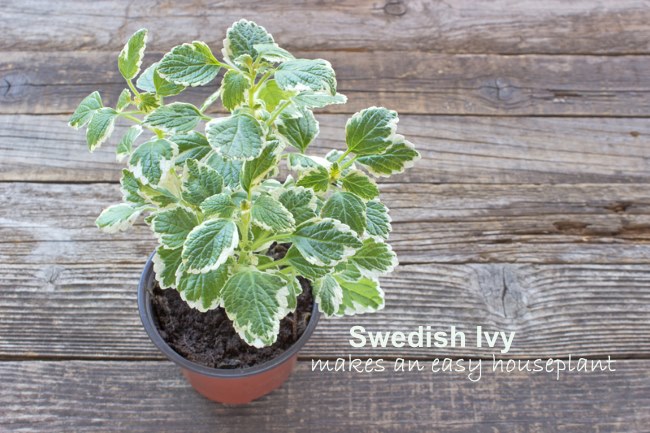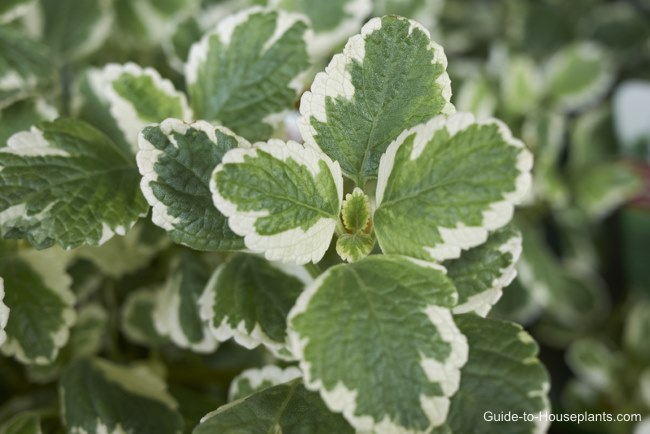Swedish Ivy
Botanical Name: Plectranthus species
Swedish ivy house plants are ideal for beginners. Nearly foolproof, this is one of the easiest types of ivy to grow indoors. In fact, it needs little attention to thrive.
 Mounds of variegated, scalloped leaves make Plectranthus captivating. Photo ©Gavran333
Mounds of variegated, scalloped leaves make Plectranthus captivating. Photo ©Gavran333Get to Know Swedish Ivy
This bushy plant has thick stems that grow upright at first, then trail over the sides of a container. Put it in a hanging basket to show off its thickly leaved cascading stems.
Swedish ivy has rounded leaves that are deeply veined with scalloped edges. P. australis is a variety with solid green foliage. The variegated types are more commonly grown as house plants.
Many varieties are available. Choose the one you like -- they're all easy to grow. The variegated types of ivy plants are most popular as houseplants. 'Marginatus' has scalloped leaves broadly edged with creamy white. 'Variegata' is another type with white variegation.
Does Swedish Ivy bloom? Yes. You can expect pale lavender or white flowers to appear in spring or summer, but they're not nearly as showy as the foliage.
Did you know...
This old-time favorite houseplant is neither native to Sweden, nor is it a true ivy.
It's actually in the Labiatae family, along with mint (Menthe) and is fast-spreading when planted in the garden.
Keep it indoors year-round. Plectranthus is a tropical native and prefers the same warm temperatures we do.
Swedish Ivy Solutions, Answers and How-tos
Pinch and prune. This vigorous grower needs regular pruning to keep it in shape. After the flowers fade, snip off stem tips to encourage branching. You'll get a fuller, bushier plant this way. Propagate the stem tips, if you like. They root easily and will provide an ongoing collection of new plants. You can prune your plant back by as much as half at a time -- you won't hurt this robust plant at all.
Wondering when to repot? Move it up when the plant is crowded in its pot. Spring is the best time, when Plectranthus begins its most vigorous time to growth. Use a pot with a drainage hole to prevent soggy soil.
Something bugging your plant? Watch for fungus gnats that are attracted to wet, peaty potting mixes. Also check for mealybugs and spider mites. Isolate any infested houseplant and treat it right away with insecticidal soap.
 Plectranthus forsteri 'Marginatus' grows an abundance of leaves. Photo ©Simona Pavan
Plectranthus forsteri 'Marginatus' grows an abundance of leaves. Photo ©Simona PavanSwedish Ivy Plant Care Tips
Origin: Northern Australia, Pacific Islands
Height: To 3 ft (90 cm)
Light: Bright, indirect light. Some morning sun is fine. Plants that don't get enough light will have leggy stems with wide gaps between leaves. Move your ivy to a brighter spot, but keep it out of harsh, direct sunlight.
Water: Swedish Ivy grows best with evenly moist soil spring through fall. Take care not to allow the soil to become soggy, which can cause root rot. If your plant wilts despite regular watering, it is probably suffering from root rot. If this happens, take a few stem cuttings from the healthiest stems and propagate them. Get rid of the parent plant -- it won't recover. Water sparingly winter, when growth has slowed, but don't allow it to dry out completely.
Humidity: Average room (around 45% relative humidity). Indoor air can become extremely dry during the winter months. Use a cool-mist room humidifier, if needed.
Temperature: Average room temperatures (65-75°F/18-24°C) year-round. This tropical plant doesn't like the cold, so keep it at a minimum of 60°F/16°C.
Soil: Peat moss-based potting mix
Fertilizer: Feed monthly spring through fall with a balanced liquid fertilizer (such as 10-10-10 N-P-K). Do not feed in winter when growth is slow.
Propagation: Take stem cuttings in spring or summer. They'll root easily in water or moist potting mix.


